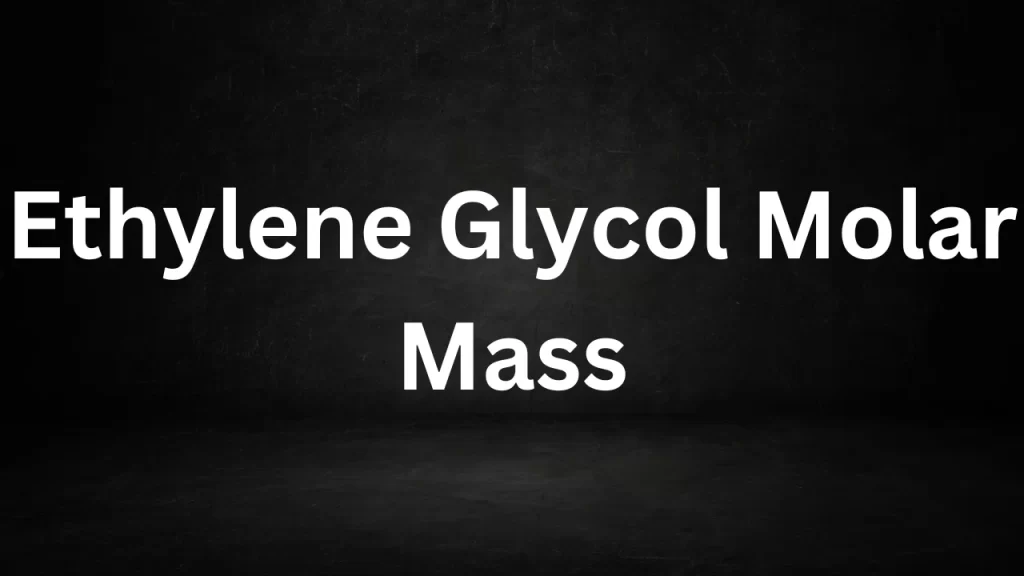Tag: ethylene glycol and diethylene glycol
Ethylene Glycol Molar Mass
Ethylene Glycol Molar Mass: Ethylene glycol is a common organic compound with a wide range of applications, from its use as a coolant in automobile radiators to its role as a key ingredient in the production of antifreeze.
Understanding the molar mass of ethylene glycol is essential in various chemical processes and industries. In this article, we will explore what molar mass is, how it relates to ethylene glycol, and its significance in practical applications.

Ethylene Glycol Molar Mass
What Is Molar Mass?
Molar mass, also known as molecular weight, is a fundamental concept in chemistry. It refers to the mass of one mole of a substance, expressed in grams per mole (g/mol). A mole is a unit that represents a specific number of atoms, molecules, or ions, approximately 6.022 x 10^23 entities, known as Avogadro’s number. The molar mass of a substance is numerically equal to its atomic or molecular weight.
Ethylene Glycol Composition
Ethylene glycol’s formula, C2H6O2, signifies two carbon (C) atoms, six hydrogen (H) atoms, and two oxygen (O) atoms per molecule. To determine ethylene glycol’s molar mass (C2H6O2), add the atomic masses of each element in its chemical formula together.
The atomic mass of carbon (C) is around 12.01 g/mol, hydrogen (H) is roughly 1.01 g/mol, and oxygen (O) is about 16.00 g/mol. Calculating the mol mass of ethylene glycol is as follows:
To calculate the molar mass of C2H6O2, sum the products of each element’s atomic mass by its respective count.
Molar Mass of C2H6O2 = (2 x 12.01 g/mol) + (6 x 1.01 g/mol) + (2 x 16.00 g/mol) ≈ 62.08 g/mol
Therefore, the mol mass of ethylene glycol is approximately 62.08 grams per mole (g/mol).
Significance of Ethylene Glycol Molar Mass
- Antifreeze Formulation: Ethylene glycol is a primary component of antifreeze, which prevents freezing and overheating in vehicle cooling systems. Accurate molar mass knowledge is essential for formulating effective and safe antifreeze products.
- Chemical Reactions: Mol mass plays a crucial role in chemical reactions involving ethylene glycol, such as its reaction with acids to produce esters or its use as a reactant in the synthesis of various organic compounds.
- Industrial Processes: Ethylene glycol is used in various industrial applications, including as a heat transfer fluid, deicing agent, and in the production of polyester fibers. Understanding its molar mass is vital for precise manufacturing processes.
- Environmental Considerations: Ethylene glycol’s molar mass is critical in evaluating its environmental impact, especially upon release, facilitating the assessment of ecological consequences.
Conclusion
The mol mass of ethylene glycol is a fundamental concept in chemistry, significant in various practical applications, including automotive maintenance and industrial processes. Understanding and applying this concept enables scientists and professionals to responsibly use ethylene glycol in various industries, promoting safety, efficiency, and environmental responsibility.
Read More
- Organisms And Population Class 12
- Difference Between Capacitor And Inductor
- Van De Graaff Generator
- Dielectric Polarization In Polar And Nonpolar Material And Dielectric Constant
- Chemistry In Everyday Life
Frequently Asked Questions (FAQs) On Ethylene Glycol Molar Mass
What is molar mass, and why is it important in chemistry?
Mol mass, often called molecular weight, represents the mass of one mole of a substance in grams per mole (g/mol). This concept is foundational in chemistry, assisting in stoichiometry—determining substance quantities in chemical reactions and various practical applications.
What is the chemical formula of ethylene glycol?
Ethylene glycol’s formula, C2H6O2, reveals two carbon (C), six hydrogen (H), and two oxygen (O) atoms per molecule.
How is the molar mass of ethylene glycol calculated?
To calculate the mol mass of ethylene glycol (C2H6O2), add the atomic masses of carbon (C), hydrogen (H), and oxygen (O) in its chemical formula: To find the molar mass of C2H6O2, add twice the atomic mass of carbon, six times the atomic mass of hydrogen, and twice the atomic mass of oxygen.
What is the molar mass of ethylene glycol?
The mol mass of ethylene glycol (C2H6O2) is approximately 62.08 grams per mole (g/mol).
Why is the molar mass of ethylene glycol important in antifreeze formulation?
Ethylene glycol is a key component of antifreeze used in vehicle cooling systems. Its molar mass is essential in formulating antifreeze to ensure the proper performance and safety of the product.